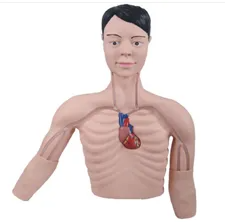Welcome to visitShanghai Chinon medical Model & Equipment Manufacturing Co., LTD
PICC interventional training model plays a vital role in medical education and clinical skills training, which effectively Bridges the gap between theoretical knowledge and practical operation. Here's how to make the leap:
PICC intervention training model provides trainees with an operating environment close to the real human body. These models are usually based on the upper body structure of an adult and have distinct anatomical surface markers that enable students to clearly identify and operate in a simulated environment.

In the training process, PICC intervention training model makes the theoretical knowledge and practical operation can be closely combined. Students first master the basic principles, indications, contraindications and operational procedures of PICC catheterization through classroom learning. Subsequently, repeated exercises are carried out in a simulated environment to consolidate and deepen theoretical knowledge through practical operations. This combination of theory and practice helps students to better understand and master PICC tube placement technology.
PICC intervention training model can also provide real-time feedback to students' operation, point out existing problems and shortcomings, and help students correct mistakes and improve operation skills in time. This real-time feedback and evaluation mechanism helps students quickly master PICC placement techniques and improve their operational skills.
Through extensive simulation exercises and real-time feedback assessment, participants are able to accumulate extensive PICC tube placement experience in a safe, risk-free environment. This not only helps to improve the clinical skills of the participants, but also enhances their self-confidence and ability to cope with complex situations. When the trainees really face the patients, they can complete the PICC catheterization operation more leisurely, and provide patients with safer and more effective medical services.
In summary, the PICC interventional training model effectively bridged the gap between theoretical knowledge and practical operation through the close combination of theory and practice, real-time feedback and evaluation, and the promotion of clinical skills and confidence. It plays an irreplaceable role in medical education and clinical skills training.
|
NEXTпјљHow does the cephalic artery model show the cerebral artery system?
LASTпјљ The intramuscular injection module facilitates skill development training |
Return list |